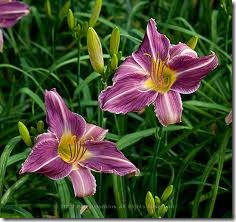The humble tawny "ditch lily" and cheerful lemon lily, once condemned as weeds, have evolved into established stars of the perennial gardens. Today’s hemerocallis cultivars sport a wide variety of bloom and foliage types from which to choose.
History
-
H. flava is an escapee from early gardens.
Hemerocallis fulva (tawny) and H. flava (lemon) daylilies are Asian natives brought to the New World by European colonists. Hybridization began with these varieties in the early 20th century.
The Basics
-
 Each bud on a daylily scape blooms for just one day.
Each bud on a daylily scape blooms for just one day.Multiple lily-shaped flowers bloom on 30- to 36-inch scapes over thick grassy leaves that grow in mounds from fan-shaped crowns. Hybrid colors range from violet and red through cream and white, many with eyes, streaks or spots.
Blooms
-
 This triangular single bloom has wide, ruffled segments with a medial white stripe.
This triangular single bloom has wide, ruffled segments with a medial white stripe.Daylily flower segments grow in multiples of three; a single form has six segments, a double, nine or more. Blooms may have short, fat, long, thin, flat, ruffled or recurved segments. They may form a circle, star, triangle, trumpet or spider shape.
Foliage
-
 This daylily has short scapes, an informal bloom and coarse leaves.
This daylily has short scapes, an informal bloom and coarse leaves.Foliage is grassy or fern-form on evergreen, semi-evergreen or dormant (deciduous) plants. It may be fine, thin or thick like corn leaves; color may be pale yellow-green to dark blue-green.
Size
-
 Lemon lilies bloom early, towering over grassy bases on 3-foot scapes.
Lemon lilies bloom early, towering over grassy bases on 3-foot scapes.Blooms range from about 2 to 5 inches across. Scapes rise 1 to to 4 feet above 6- to 36-inch mounds of foliage.


Deprecated: strpos(): Passing null to parameter #1 ($haystack) of type string is deprecated in /home/agriviek8Qv/agriviet.net/public_html/wp-includes/comment-template.php on line 2522